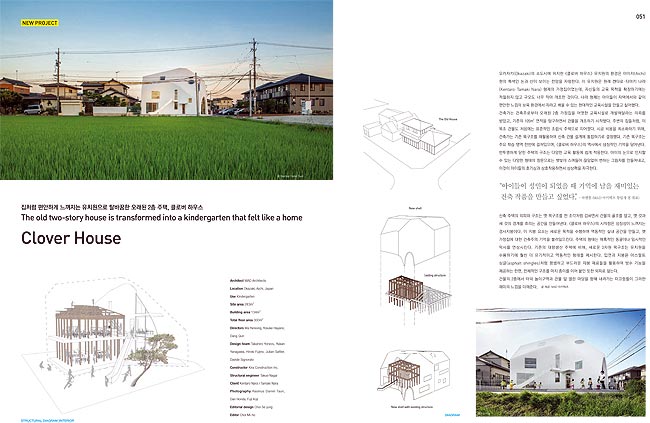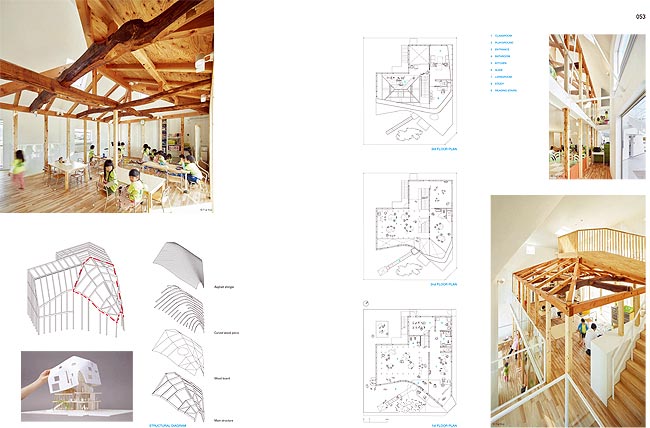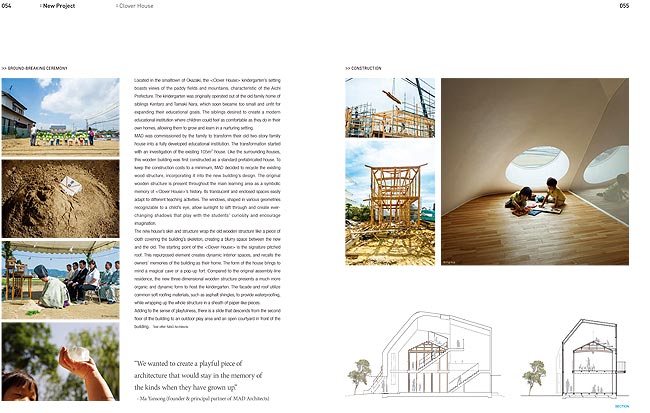CLOVER HOUSE
MAD ARCHITECTS



오카자키(Okazaki)의 소도시에 위치한 <클로버 하우스> 유치원의 환경은 아이치(Aichi) 현의 특색인 논과 산이 보이는 전망을 자랑한다. 이 유치원은 원래 켄타로·타마키 나라 (Kentaro·Tamaki Nara) 형제의 가정집이었는데, 자신들의 교육 목적을 확장하기에는 적절하지 않고 규모도 너무 작아 개조한 것이다. 나라 형제는 아이들이 자택에서와 같이 편안한 느낌의 보육 환경에서 자라고 배울 수 있는 현대적인 교육시설을 만들고 싶어했다.
건축가는 건축주로부터 오래된 2층 가정집을 어엿한 교육시설로 개발해달라는 의뢰를 받았고, 기존의 105m2 면적을 탐구하면서 건물을 개조하기 시작했다. 주변의 집들처럼, 이 목조 건물도 처음에는 표준적인 조립식 주택으로 지어졌다. 시공 비용을 최소화하기 위해, 건축가는 기존 목구조를 재활용하여 신축 건물 설계에 통합하기로 결정했다. 기존 목구조는 주요 학습 영역 전반에 걸쳐있으며, <클로버 하우스>의 역사에서 상징적인 기억을 담아낸다. 반투명하게 닫힌 주택의 구조는 다양한 교육 활동에 쉽게 적응한다. 아이의 눈으로 인지할 수 있는 다양한 형태의 창문으로는 햇빛이 스며들어 끊임없이 변하는 그림자를 만들어내고, 이것이 아이들의 호기심과 상호작용하면서 상상력을 자극한다.
신축 주택의 외피와 구조는 옛 목구조를 천 조각처럼 감싸면서 건물의 골조를 덮고, 옛 것과 새 것의 경계를 흐리는 공간을 만들어낸다. <클로버 하우스>의 시작점은 상징성이 느껴지는 경사지붕이다. 이 지붕 요소는 새로운 목적을 수행하며 역동적인 실내 공간을 만들고, 옛 가정집에 대한 건축주의 기억을 불러일으킨다. 주택의 형태는 매혹적인 동굴이나 임시적인 막사를 연상시킨다. 기존의 대량생산 주택에 비해, 새로운 3차원 목구조는 유치원을 수용하기에 훨씬 더 유기적이고 역동적인 형태를 제시한다. 입면과 지붕은 아스팔트 싱글(asphalt shingles)처럼 평범하고 부드러운 지붕 재료들을 활용하여 방수 기능을 제공하는 한편, 전체적인 구조를 마치 종이를 이어 붙인 듯한 외피로 덮는다. 건물의 2층에서 야외 놀이구역과 건물 앞 열린 마당을 향해 내려가는 미끄럼틀이 그러한 재미의 느낌을 더해준다.
글 제공: MAD 아키텍츠
Located in the smalltown of Okazaki, the [Clover House] kindergarten’s setting boasts views of the paddy fields and mountains, characteristic of the Aichi Prefecture. The kindergarten was originally operated out of the old family home of siblings Kentaro and Tamaki Nara, which soon became too small and unfit for expanding their educational goals. The siblings desired to create a modern educational institution where children could feel as comfortable as they do in their own homes, allowing them to grow and learn in a nurturing setting.
MAD was commissioned by the family to transform their old two-story family house into a fully developed educational institution. The transformation started with an investigation of the existing 105m2 house. Like the surrounding houses, this wooden building was first constructed as a standard prefabricated house. To keep the construction costs to a minimum, MAD decided to recycle the existing wood structure, incorporating it into the new building’s design. The original wooden structure is present throughout the main learning area as a symbolic memory of [Clover House]’s history. Its translucent and enclosed spaces easily adapt to different teaching activities. The windows, shaped in various geometries recognizable to a child’s eye, allow sunlight to sift through and create everchanging shadows that play with the students’ curiosity and encourage imagination.
The new house’s skin and structure wrap the old wooden structure like a piece of cloth covering the building’s skeleton, creating a blurry space between the new and the old. The starting point of the [Clover House] is the signature pitched roof. This repurposed element creates dynamic interior spaces, and recalls the owners’ memories of the building as their home. The form of the house brings to mind a magical cave or a pop-up fort. Compared to the original assembly-line residence, the new three-dimensional wooden structure presents a much more organic and dynamic form to host the kindergarten. The facade and roof utilize common soft roofing materials, such as asphalt shingles, to provide waterproofing, while wrapping up the whole structure in a sheath of paper-like pieces. Adding to the sense of playfulness, there is a slide that descends from the second floor of the building to an outdoor play area and an open courtyard in front of the building.
Text offer: MAD Architects
건축문화 2016년 10월호 [New Project]페이지 © 에이엔씨출판(주)